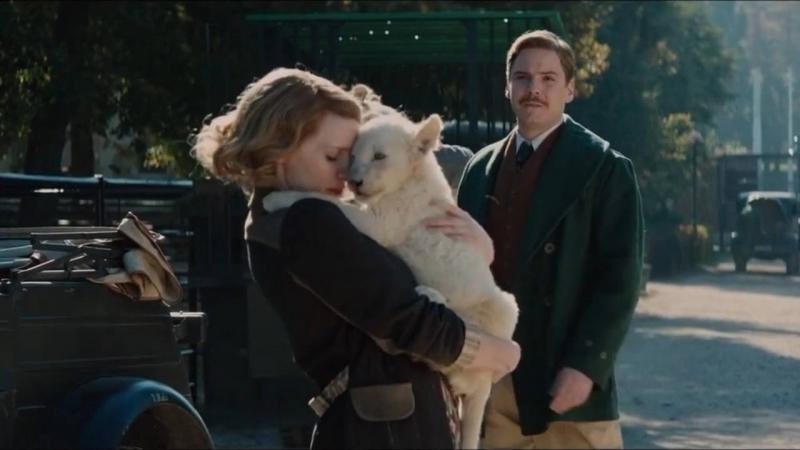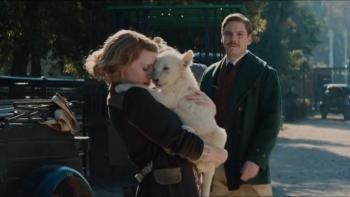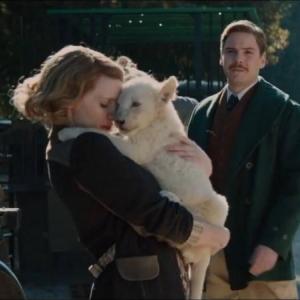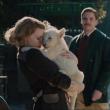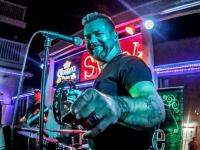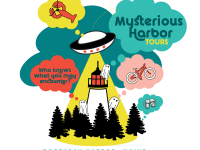‘The Zookeeper’s Wife’: A powerful recounting of resistance during the Holocaust
As I anticipated, “The Zookeeper’s Wife” is an emotional, inspirational and memorable film – and it’s playing at The Harbor Theatre.
The film closely follows Diane Ackerman’s book of the same title, published in 2007 and based on the unpublished diary of Antonina Żabińska about the three years (1942-45) she and her husband Jan Żabiński, director of the Warsaw Zoo, were part of the resistance and underground in WW II Poland.
The screenplay written by Angela Workman, the international cast led by Jessica Chastain and Johan Heidenbergh as the Zabinskis, and cinematography by Andrij Parekh, make this an unforgettable theater experience.
The film takes place in Warsaw, Poland in 1939. Jan Zabinski is the director of the Miejski Ogŕod Zoologiczny (we know it as the Warsaw Zoo) and Antonina is his assistant. Antonina has an innate way of communicating with animals, loving and compassionate, she’s the zoo animal equivalent of a horse whisperer.
For example, the evening of Aug. 31, during a party held by the Zabinskis at their home, one of their zookeepers rushes in and excitedly tells Antonina she is needed in the elephant habitat. Something is wrong. She rushes to the elephants (with the guests following) to find a newborn calf is not breathing. While frantically trying to clear the blockage from the calf’s trunk, Antonina is also trying to comfort Lily, the mother, whose trunk is repeatedly reaching for Antonina.When the calf begins to breathe, Antonina isn’t the only one crying of happiness and relief. You will be, too.
From this heartwarming scene comes the morning of September 1, 1939, the day the German Army began its invasion of Poland. A brutal air raid on Warsaw, including the zoo, ensues just after Antonina opens it and people have been welcomed in. This horrific scene is emotion-packed and skillfully filmed.
The Zabinski’s closest friends, artist Magda Gross (played by Efrat Dor) and scientist Maurycy Fraenkel (Iddo Goldberg) are Jewish. Maurycy tells them he wants Magda to get out of Warsaw as the rounding up of people of their faith intensifies. Antonina says Magda will stay at the zoo with them, but, with the Germans now using the zoo as an armory, Magda must keep silent all day until they leave at midnight. Magda will know it is safe to come out of hiding when she hears Antonina playing the piano. But if Magda ever hears her play the piano during the day, she has to hide.
Lutz Heck, an acquaintance of Jan’s from their childhood days, pays a visit to the zoo and proposes taking the best of the Zabinskis’ surviving breeds to the Berlin Zoo where he is now the director since his father’s death. Why? The Germans have decided to liquidate the Warsaw Zoo. Heck says it will only be until such time when it is safe to bring them back. She agrees, but the day they are taken Antonina can hardly bear it.
It gets worse. When winter arrives, Heck tells the soldiers to kill the rest of the Zabinskis’ animals with the excuse that they won’t survive the winter. So, one New Year’s Eve, for sport, the soldiers follow their orders while a horrified Antonina tries to comfort her frightened son.
One day while Jan, a member of the Polish Underground Resistance, is driving to the store with his son, he sees two German soldiers taking a teen-aged girl, Urszula (Shira Haas) into an alley. On his way back home, he sees her stumble out from the alley, blood dripping down one leg, clothes torn, dirt on her face and clearly in shock. She tries to cry out, but she is too afraid. Jan stops the truck and tries to get her inside as quickly as possible. Jan places her on the floor of the truck and covers her with his coat.
Once back at the zoo, Jan tells Antonina that they must give sanctuary to more than just Magda, they must help as many Jewish refugees as they can, until the Resistance can get them out of Poland. Says Antonina, “A human zoo.” Jan then tells her about the girl in the truck. They gently bring her into the basement of their home where there are indoor cages that previously provided shelter for the Zabinskis’ zoo family.
When they learn the German war office is closing the zoo, Antonina and Jan go to visit Heck. To protect their efforts to save refugees, they propose raising pigs in the cages their zoo animals used to be in to feed the soldiers and that they will feed them by collecting food scraps from the ghetto. This will also give Jan a reason to go there and bring out two to three people a trip. Jan throws in some of the scraps, the people jump in and he covers them with the rest.
During that visit, Heck proposes bringing his experimental animal breeding effort to the former zoo. He tells the couple he and his brother have been experimenting to bring back extinct breeds such as the aurorch or urus (a very large wild species of cattle with large horns) that used to roam in the Jaktorów Forest in the 17th century, by breeding them with cattle descended from them. Jan ticks Heck off when he tells him that what he’s trying to do is impossible.
Days after Urszula has been rescued, in an attempt to comfort the girl and gain her trust, Antonina, holding a baby rabbit, tells her about her own family’s years of being in hiding. About how her father was shot in front of her in St. Petersburgh. Antonina shares that when you spend your life in hiding, “You can never tell who your enemies are or who to trust. Maybe that’s why I love animals so much; when you look into their eyes you know exactly what’s in their hearts. It’s not the same with people.” Antonina sets the rabbit down in the hay next to Urszula who picks it up.
It isn’t until a family of five are rescued and come to the basement that Urszula speaks for the first time. The two boys ask Urszula if they can hold her rabbit. She passes it to them. They begin asking her questions, starting with her name … Eventually she even begins joining all of the other refugees upstairs in the Zabinskis’ home until the Germans return early in the morning. To pass the time they must spend in hiding, Urszula shares the crayons and paints Antonina gave her with the others and together they create a mural, much like those of ancient cultures.
To prepare the refugees for transport, Antonina and Magda dye some of the women’s hair different shades of blonde. Antonina calls them aunts and cousins as she waves goodbye while they get into a car or truck on the road to freedom.
The Zabinskis are not the only ones involved in the resistance efforts – there’s the bakery where fake documentation is created There’s a professor-type friend of Maurycy’s that gets Jan clearance to be in the ghetto as his assistant – and helps get a very ill Maurycy out of where he is being kept prisoner.
There’s the Rabbi that stays in the ghetto with the children separated from their parents. Jan tries to persuade him to leave but the Rabbi refuses, even as they are loading the children into the train cars to the camps. Like with many scenes in the film that came before this one, many of you may be moved to tears – as I was (and I believe Mr. Sheckley as well). The Germans take the suitcases from the kids and throw them into a pile to be burned – along with the ghetto itself. And as the ghetto burns, tiny pieces of clothing and such are carried on the wind. Rhyszard sees it through the windows of the Zambinskis’ house and tells his mother it’s “snowing.”
In the film, Heck’s admiration for Antonina develops into an attraction (this “relationship” was not in the real life Antonina’s diaries). One day Heck shows up at the Zabinskis’ door unexpectedly, Antonina rushes to lock the basement door and lets him in. Downstairs the two boys begin a bit of rough-housing that is heard by Heck. When he asks Antonina what the noise was, since they are in a doorway she reaches for his face and buries it in her neck to distract him.
The day he decides to breed the ox and bison Heck asks Antonina to help him; he needs her to comfort the female as the bison does the deed. Not a pleasant scene. As the two are washing their hands, Heck begins soaping Antonina’s hands, both unaware that this time, Jan is watching them.
The couple argues. How far is Antonina supposed to go? Jan says he didn’t sign on for this – for his wife to be caressed and who knows what else by Heck. Antonina has to keep Heck on their side and said that nothing else had transpired between them. But, she reminds Jan, he is gone for days at a time leaving her to deal with the Germans, protecting their son and the refugees; she must keep Heck on their side. Heck must not suspect them of anything.
How it all ends, well most of that is in Antonina’s diaries, on which this film is based, and the rest is recorded history. This film has been criticized for the minor elements it includes of Jan’s life fighting with the underground and the other work he was involved in. Just remember the film is derived from the book built on Antonina’s diary and that she was not aware of everything Jan was doing when he was away.
Jan and Antonina Zabinski rescued 300 Jewish men, women and children from the death camps. Two did not survive – two women living at a boarding house where somebody there gave them up. Two German soldiers took them outside the boarding house and shot them in the street.
This film is a story of courage, of the importance of love and respect for all of humanity and the creatures we share this world with. It is also a testimonial to the power of resistance.
Chastain’s performance is so strong it may make her an Oscar contender and Shira Haas’ portrayal of the young rape victim is compelling and sensitively delivered.
“The Zookeeper’s Wife” is playing at The Harbor Theatre, 185 Townsend Avenue here in Boothbay Harbor at 7 p.m. on Friday, May 5 and Saturday, May 6, Wednesday, May 10 and Thursday, May 11; two screenings on Sunday, May 7 at 2 and 7 p.m.
Event Date
Address
185 Townsend Avenue
Boothbay Harbor, ME 04538
United States

